
A leisure battery is vital to any leisure vehicle, providing the necessary power to run various electrical devices and appliances. However, to ensure that the battery is always ready for use, it is crucial to know how to charge it correctly and how long to charge it?. How to charge a Leisure battery?
On an average, When charging a leisure battery, it is important to ensure that the correct type of charger is used. A leisure battery should not be charged using a car or regular household charger, as this could cause damage to the battery or even pose a safety risk.
How long to charge a leisure battery?
Generally, it can take 8-10 hours to fully charge a leisure battery. It’s recommended to consult the manufacturer’s instructions for the specific battery and charger used to determine the appropriate charging time.
Here are some general points on how long it may take to charge a leisure battery using different charging types:
| 1. | Mains charger | A mains charger is a common way to charge a leisure battery. Depending on the size of the battery, it can take between 4 to 12 hours to fully charge a leisure battery using a mains charger. |
| 2. | Solar charger | The charging time using a solar charger can vary depending on the weather conditions and the solar panel output. It can generally take 8 to 48 hours to fully charge a leisure battery using a solar charger. |
| 3. | Alternator | The alternator’s charging time can vary depending on the alternator’s output and the battery’s condition. Using an alternator, it can take several hours of driving to fully charge a leisure battery. |
| 4. | Battery charger | Depending on the battery charger’s output and capacity, it can take 4 to 12 hours to fully charge a leisure battery using a battery charger. |
Instead, a specific leisure battery charger should be used to deliver a constant current charge until the battery reaches full capacity.
The length of time required to fully recharge a leisure battery depends on several factors, such as the battery’s capacity and the discharge level before charging.
As a general rule, it is recommended to charge for at least 12 hours but consult manufacturer recommendations for guidance on charging times specific to your model of leisure battery.
Overcharging can also deplete your battery’s health, so disconnect as soon as possible when fully charged for long-term performance.
This article will provide a comprehensive guide on charging a leisure battery and how long it should be charged, considering different factors that may affect the charging time.
We will also discuss different types of leisure batteries and offer tips for maintaining them to ensure they are always in optimal condition.
Whether you’re a seasoned caravan, motorhome owner, or a newbie, this guide will help you understand the best practices for charging and maintaining your leisure battery to ensure it performs at its best when needed.
How To Charge Leisure Battery From Mains Hook-Up?
A leisure battery is crucial in a leisure vehicle as it provides power to run various electrical devices and appliances.
Charging the leisure battery from a main hook-up is a common method many leisure vehicle owners use. It is a relatively straightforward process that requires the correct charger and some basic precautions.
This tweet states he set up an off-grid charging station to charge the leisure batteries!
We will provide a step-by-step guide on charging a leisure battery from a mains hook-up, including choosing the right charger, preparing the battery for a charge, connecting the charger to the battery, monitoring the charging process, and disconnecting the charger.
“It is important to use a charger that matches the type of battery you have to ensure efficient and safe charging.“
– Mark Pollock, author of “The Motorhome Diaries: Travels with My Wife in Their Motorhome.”
Charging a leisure battery from a main hook-up is a common method many leisure vehicle owners use.
To charge your leisure battery from a mains hook-up, follow these steps:
| 1. | Choose the right charger | Make sure the charger is compatible with your battery type, as different types of batteries require different charging methods. |
| 2. | Prepare the battery for charge | Before connecting the charger, make sure the battery is clean and free from any dirt or debris. Also, ensure that the battery terminals are tight and corrosion-free. |
| 3. | Connect the charger to the battery | Connect the charger to the battery, following the manufacturer’s instructions. Ensure the charger is switched off before connecting the leads to the battery terminals. |
| 4. | Switch on the charger | Once it is connected, switch it on and set it to the correct charging rate for your battery. This information should be provided in the battery manufacturer’s instructions. |
| 5. | Monitor the charging process | While the battery is charging, monitor it regularly to ensure it is not overheating or overcharging. Overcharging can cause the battery to become damaged or even explode. |
| 6. | Disconnect the charger | Disconnect the charger from the battery terminals and switch it off once the battery is fully charged. |
Charging times may vary depending on the type and condition of the battery, as well as the charging rate of the charger.
It is recommended to check the battery’s voltage regularly during charging to ensure it does not overcharge, which can cause permanent damage to the battery.
Refer to the battery and charger manufacturer’s instructions for specific guidance on charging your leisure battery from a mains hook-up.
How Long To Charge Leisure Battery From Mains?

The charging time for a leisure battery from a mains hook-up can vary depending on several factors, such as the battery’s capacity, current charge level, and the charger’s charging rate.
On an average, a leisure battery can take between 8 to 12 hours to fully charge from an AC outlet with a standard battery charger. However, some chargers have fast charging technology that can reduce this time by up to half.
To ensure optimum performance and maximize battery life, it is recommended to use a smart charger specifically designed for leisure batteries that can automatically adjust the charging rate based on the battery’s condition.
The charging time is also affected by the type of battery you have. For example, lead-acid batteries require a longer charging time than lithium-ion batteries.
It is essential to check the battery’s voltage regularly during the charging process to ensure it is not overcharging, which can damage the battery.
Overcharging can cause the battery to lose its capacity and ultimately fail.
To determine the charging time for your specific battery, consult the manufacturer’s instructions, which should provide information on the recommended charging time and rate for your specific battery.
Investing in a smart charger that can automatically adjust the charging rate based on the battery’s needs and prevent overcharging is also recommended.
In summary, the charging time for a leisure battery from a mains hook-up can vary depending on the battery’s capacity, current charge level, charging rate, and type of battery.
Always refer to the battery and charger manufacturer’s instructions for specific guidance on charging times to ensure the battery is not overcharged and damaged.
This tweet shows the latest 7-pin socket charging the leisure batteries!
Charging A Leisure Battery With A Solar Panel
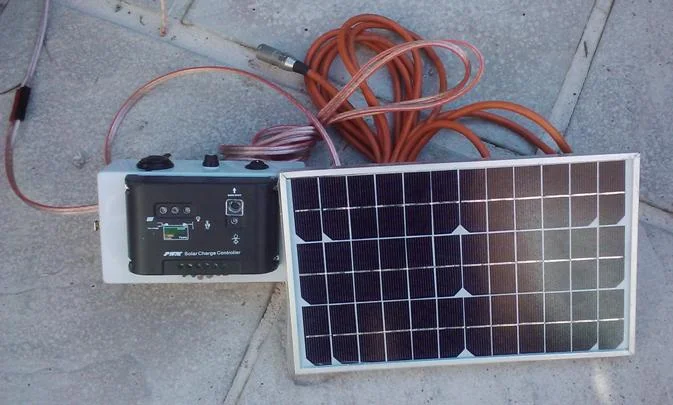
Charging a leisure battery with a solar panel is an excellent way to keep your battery charged when you’re off-grid or when mains hook-up is unavailable.
Solar panels convert sunlight into electrical energy, which can be used to charge the battery.
Here are the steps to charge a leisure battery with a solar panel:
| 1. | Choose the right solar panel | Select one suitable for your leisure battery’s capacity. A general rule of thumb is to use a panel with a power output of at least 10% of your battery’s capacity. |
| 2. | Position the solar panel | Place the solar panel in an area that receives plenty of sunlight, ideally facing the sun. The panel should be angled towards the sun for maximum efficiency. |
| 3. | Connect the solar panel to the battery | Ensure the solar panel’s positive and negative cables are connected to the battery’s positive and negative terminals. |
| 4. | Monitor the charging process | While the battery is charging, monitor it regularly to ensure it is not overcharging. Overcharging can cause the battery to become damaged or even explode. |
| 5. | Disconnect the solar panel | Once the battery is fully charged, disconnect the solar panel from the battery terminals. |
The charging time for a leisure battery with a solar panel can vary depending on the solar panel’s power output, the battery’s capacity, and the current charge level.
It is recommended to check the battery’s voltage regularly during charging to ensure it does not overcharge, which can cause permanent damage to the battery.
Investing in a solar charge controller, which regulates the charging rate to prevent overcharging and ensure the battery’s optimal performance, is also advisable.
In summary, charging a leisure battery with a solar panel is an excellent way to keep your battery charged when off-grid.
“The charging time of a leisure battery can vary depending on factors such as the battery’s capacity and the charging method used.”
– John Wickersham, author of “The Caravan & Motorhome Book: The Essential Guide to Choosing, Financing, and Enjoying Your Leisure Vehicle.”
Ensure you select the right solar panel, position it correctly, connect it to the battery, monitor the charging process, and disconnect the solar panel once fully charged.
Want to know what a split charge relay is? Then click on this video link!
Campervan 240v Battery Charger
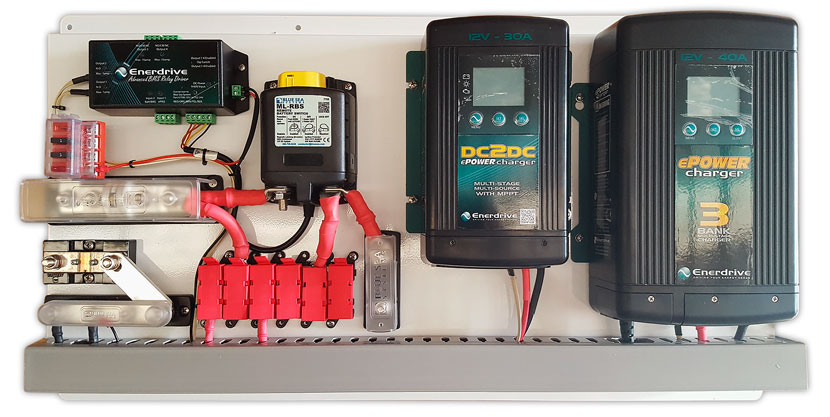
A campervan 240V battery charger is a device that converts 240V AC power from a mains supply into 12V DC power to charge a campervan leisure battery.
These chargers are commonly used to charge batteries in campervans, caravans, and motorhomes connected to a mains hook-up.
Here are the steps to use a campervan 240V battery charger:
| 1. | Choose the right charger | Select one suitable for your battery’s capacity and chemistry. Chargers are available in different sizes and types, so choosing the right one for your battery is essential. |
| 2. | Connect the charger to the battery | Ensure the charger’s positive and negative cables are connected to the battery’s positive and negative terminals. |
| 3. | Connect the charger to the mains | Connect the charger to the mains supply using a suitable cable. Ensure the charger is switched off before connecting it to the main supply. |
| 4. | Turn on the charger | Turn on the charger and monitor the charging process regularly. The charger may display the battery’s voltage, charging current, and charging status. |
| 5. | Disconnect the charger | Disconnect the charger from the terminal and mains supply once the battery is fully charged. |
The charging time for a campervan leisure battery using a 240V battery charger can vary depending on the battery’s capacity, current charge level, and charging rate.
It is recommended to check the battery’s voltage regularly during charging to ensure it does not overcharge, which can cause permanent damage to the battery.
In summary, a campervan 240V battery charger is essential for charging your campervan’s leisure battery when connected to a mains hook-up.
Ensure you choose the right charger, connect it to the battery and mains supply, turn it on, monitor the charging process, and disconnect the charger once it is fully charged.
Importance Of Leisure Battery
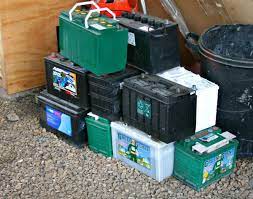
Leisure batteries are crucial to any campervan, caravan, or motorhome setup.
They provide a reliable power source for essential equipment such as lighting, heating, fridges, and other electrical appliances when no mains hook-up is available.
Here are some of the reasons why a leisure battery is important:
- Power source:
A leisure battery provides a reliable power source when you are off-grid or when the mains hook-up is unavailable. It allows you to power essential equipment such as lighting, heating, and appliances, making your campervan more comfortable and convenient.
- Emergency backup:
A leisure battery can also act as an emergency backup power source in case of a power outage or when your vehicle’s engine battery fails. It ensures you always have power when you need it.
- Mobility:
A leisure battery allows you to be mobile and explore remote locations without needing a main hook-up. It allows you to travel and enjoy the outdoors without worrying about power limitations.
- Cost-effective:
Using a leisure battery can be a cost-effective way to power your campervan, caravan, or motorhome. It eliminates the need for expensive and noisy generators and reduces your reliance on main hook-ups, which can be costly at campsites.
- Environmental benefits:
Using a leisure battery also has environmental benefits as it reduces your carbon footprint by decreasing your reliance on generators and fossil fuels.
In summary, a leisure battery is essential to any campervan, caravan, or motorhome setup.
It provides a reliable power source, acts as an emergency backup, allows you to be mobile, is cost-effective, and has environmental benefits.
Therefore, it is crucial to choose the right leisure battery for your setup and ensure it is properly maintained and charged.
“It is recommended to charge your leisure battery after every use or at least once a month to prevent the battery from discharging completely and damaging the battery.“
– Martin Dorey, author of “The Camper Van Bible: Live, Eat, Sleep
Types Of Leisure Batteries
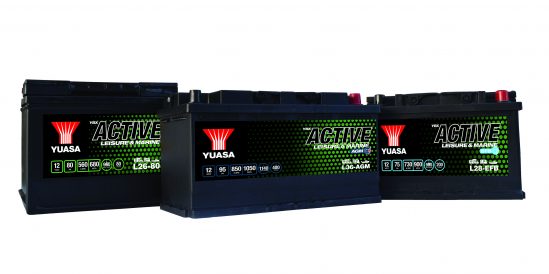
Leisure batteries are essential for anyone who owns a campervan, caravan, or motorhome.
They provide a reliable power source for essential equipment, such as lighting, heating, and appliances, when mains hook-up is unavailable.
However, choosing the right leisure battery for your needs can be overwhelming as several types of leisure batteries are available in the market.
Each type has unique features, advantages, and disadvantages, making it essential to understand the different types of leisure batteries and their characteristics.
We will discuss the different types of leisure batteries, their features, and the benefits and drawbacks of each type.
This information will help you choose the right leisure battery for your campervan, caravan, or motorhome setup.
- Flooded Lead-Acid Batteries
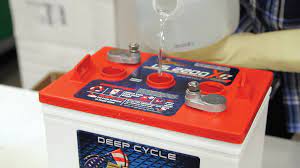
Flooded lead-acid batteries are the most common leisure batteries used in campervans, caravans, and motorhomes.
They use a liquid electrolyte, usually sulfuric acid, to create a chemical reaction that generates electricity. The electrolyte is in individual cells connected in series to provide the required voltage.
Flooded lead-acid batteries are relatively inexpensive and offer good performance for their cost. They have a long lifespan and can provide a high output of power.
They are also easy to maintain and can be recharged using various methods, including solar panels, generators, and mains hook-ups.
However, flooded lead-acid batteries require regular maintenance, as the electrolyte can evaporate, which can lead to a drop in performance and lifespan.
They also produce hydrogen gas during charging, which can be dangerous if not ventilated correctly. They are also heavy and difficult to handle, making them less suitable for portable applications.
Pros And Cons Of Flooded Lead-Acid Batteries
Here are some pros and cons of using Flooded Lead-Acid batteries:
Pros:
- Low cost: Flooded Lead-Acid batteries are relatively inexpensive compared to other types of leisure batteries.
- Easy to find: They are widely available in the market and easy to find.
- Durable: They are durable and can last many years with proper maintenance.
- High capacity: They have a high energy density and can provide high power for extended periods.
- Suitable for high-current applications: They are ideal for high-current applications such as starting an engine, making them an excellent choice for vehicles with large engines.
Cons:
- Maintenance: Flooded Lead-Acid batteries require regular maintenance, including checking the water levels and topping up the electrolyte.
- Ventilation: They require proper ventilation due to the release of hydrogen gas during charging, which can be dangerous in an enclosed space.
- Spill risk: They can spill electrolytes if not handled properly, which can be hazardous to people and the environment.
- Shorter lifespan: Flooded Lead-Acid batteries have a shorter lifespan than other leisure batteries.
- Sensitive to temperature: They are sensitive to temperature fluctuations, and extreme temperatures can shorten their lifespan.
“Using a multi-stage charger can prolong the lifespan of your leisure battery by preventing overcharging and maintaining the battery’s optimal charge level.”
– Michael Wicks, author of “The RV Handbook: Essential How-to Guide for the RV Owner.”
- Gel Batteries
Gel batteries are sealed lead-acid batteries that use gel electrolytes instead of liquid electrolytes used in traditional flooded lead-acid batteries.
The gel electrolyte is a thick paste-like substance immobilized inside the battery’s casing, making it leak-proof and maintenance-free.
Gel batteries are known for their deep cycle capabilities, which means they can discharge and recharge repeatedly without damaging or losing capacity.
They are also highly resistant to vibrations and shock, making them suitable for use in rough terrain.
One of the main advantages of gel batteries is their ability to withstand extreme temperatures.
They can operate efficiently in high- and low-temperature environments, making them ideal for campervans, caravans, and motorhomes.
However, gel batteries also have some disadvantages. They are relatively expensive compared to other leisure batteries and have a lower charge efficiency, meaning they take longer to charge and require a higher charging voltage than other types of batteries.
In summary, gel batteries are sealed lead-acid batteries that use gel electrolytes, making them leak-proof and maintenance-free.
They are highly resistant to vibrations and shock, withstand extreme temperatures, and have deep cycle capabilities.
However, they are relatively expensive and have a lower charge efficiency than other types of leisure batteries.
- Absorbent Glass Mat (AGM) batteries
Absorbent Glass Mat (AGM) batteries are sealed lead-acid batteries commonly used as leisure batteries in campervans, caravans, and motorhomes.
These batteries are constructed using a unique design that uses a fiberglass mat separator to absorb the electrolyte instead of a traditional flooded design.
This technology makes AGM batteries spill-proof, maintenance-free, and vibration-resistant, making them an excellent choice for mobile applications.
AGM batteries have several advantages over other types of leisure batteries. They have a faster recharge time, lower self-discharge rate, and a longer lifespan.
They are also suitable for deep cycle use, ideal for powering essential equipment over an extended period.
AGM batteries are also more resistant to extreme temperatures and can withstand a wider range of operating temperatures than other battery types.
One of the drawbacks of AGM batteries is their high initial cost compared to other types of leisure batteries.
They are also more sensitive to overcharging, damaging the battery, and shortening its lifespan. AGM batteries are also unsuitable for high-current applications as they have a lower capacity than other types of batteries.
AGM batteries are an excellent choice for leisure battery applications in campervans, caravans, and motorhomes.
They are spill-proof, maintenance-free, and vibration-resistant, making them ideal for mobile applications.
They have several advantages over other types of leisure batteries, including a faster recharge time, lower self-discharge rate, and longer lifespan.
However, they are more sensitive to overcharging and have a higher initial cost than other battery types.
This tweet shows the split charge system to charge the leisure batteries!
Pros And Cons Of Absorbent Glass Mat (AGM) batteries
Here are the pros and cons of AGM batteries:
Pros:
- Maintenance-free: AGM batteries are maintenance-free, as they don’t require watering or electrolyte maintenance, making them more convenient for campervan owners.
- Spill-proof: AGM batteries are spill-proof, making them safer to handle and less likely to leak and cause damage to the vehicle.
- Vibration-resistant: AGM batteries have high vibration resistance, making them ideal for use in mobile applications such as campervans, where they may experience jarring or vibration during travel.
Cons:
- Higher cost: AGM batteries are more expensive than traditional flooded lead-acid batteries, making them less affordable for some campervan owners.
- Sensitive to overcharging: AGM batteries are more sensitive to overcharging, which can lead to a shorter battery lifespan.
- Lower capacity: AGM batteries have a lower capacity than traditional flooded lead-acid batteries, making them less suitable for high-current applications.
Factors Affecting Charging Time Of Leisure Battery

Several factors can affect the charging time of a leisure battery. Here are some of the factors that can impact the charging time of a leisure battery:
| 1. | Battery capacity | The battery’s capacity is one of the most significant factors affecting the charging time. The larger the battery capacity, the longer it will take to charge fully. |
| 2. | Charging current | The charging current is another critical factor that affects the charging time. The higher the charging current, the faster the battery will charge. |
| 3. | Charger type | The charger used can also affect the charging time. A smart or multi-stage charger is more efficient and can charge the battery faster than a basic charger. |
| 4. | Battery condition | The battery’s condition can also affect the charging time. A battery that has been heavily discharged or has a high internal resistance may take longer to charge than a battery in good condition. |
| 5. | Temperature | The temperature can also affect the charging time. Batteries charge faster in warmer temperatures, but extreme temperatures can damage the battery. |
| 6. | State of charge | The state of charge of the battery can also affect the charging time. A partially charged battery will take less time than a completely discharged battery. |
| 7. | Charging method | Charging the battery using a mains hook-up, solar panel, or a 240v battery charger can have different charging times. |
In summary, several factors can affect the charging time of a leisure battery. The battery capacity, charging current, charger type, battery condition, temperature, state of charge, and charging method are all factors that can impact the charging time.
Understanding these factors can help you optimize the charging time of your leisure battery and ensure it is charged efficiently and effectively.
This video shows how to install the leisure battery with a split charging system! Click on this video link to see!
How To Calculate Charging Time Of Leisure Battery?
To calculate the charging time of a leisure battery, you need to consider the battery’s capacity and the charging current.
Here are the steps to calculate the charging time:
- Determine the battery capacity: Check the battery label or specifications to determine the battery’s capacity in Ah (ampere-hours).
- Determine the charging current: Check the charger’s label or specifications to determine the charging current in A (amperes).
- Divide the battery’s capacity by the charging current: Divide the battery’s capacity in Ah by the charging current in A. The result is the estimated charging time in hours.
For example, if you have a 100Ah leisure battery and a charger that provides a charging current of 10A, the estimated charging time would be:
Charging time = Battery capacity / Charging current
Charging time = 100Ah / 10A
Charging time = 10 hours
This calculation provides an estimate of the charging time.
However, the actual charging time may vary depending on battery condition, temperature, and charging method.
“Calculating the charging time of your leisure battery is important to ensure that the battery is fully charged before your next trip.“
– Dave Arbogast, author of “The RV Lifestyle: A Dream Come True.”
Tips For Maintaining A Leisure Battery

Proper maintenance of a leisure battery can prolong its lifespan and improve its performance. Here are some tips for maintaining a leisure battery:
| 1. | Charge the battery regularly | Regular charging prevents the battery from discharging completely, which can damage the battery. Charging the battery after every use or at least once every month is recommended. |
| 2. | Use a smart charger | A smart charger is designed to maintain the battery’s optimal charge level and prevent overcharging, which can damage the battery. |
| 3. | Check the battery voltage | Use a multimeter to check the battery voltage regularly. A healthy battery should have a voltage of around 12.6V or higher when fully charged. |
| 4. | Clean the battery terminals | Use a multimeter to check the battery voltage regularly. A healthy battery should have a voltage of around 12.6V or higher when fully charged. |
| 5. | Store the battery properly | When not in use, store the battery in a cool and dry place away from direct sunlight. Avoid storing the battery in a discharged state, which can cause permanent damage. |
| 6. | Check the electrolyte level | If you have a flooded battery, check the electrolyte level regularly and top up with distilled water if necessary. |
Following these tips, you can maintain your leisure battery in good condition and prolong its lifespan.
Environmental Impact Of Leisure Battery
Like any other type of battery, leisure batteries have an environmental impact that should be considered. Batteries’ production, use, and disposal all contribute to the environmental impact.
- Firstly, the production of batteries requires the extraction of raw materials such as lead, nickel, and lithium, which can have environmental and social impacts. The mining process can cause soil erosion, water pollution, and the destruction of habitats. Additionally, transporting raw materials and finished batteries can contribute to carbon emissions and air pollution.
- Secondly, the energy consumption required to charge and discharge batteries contribute to greenhouse gas emissions, particularly if the electricity used to charge the battery comes from fossil fuels. Additionally, if batteries are not disposed of properly, they can release harmful chemicals into the environment.
- Thirdly, the disposal of batteries at the end of their lifespan can also have environmental consequences. If not properly disposed of, batteries can leak hazardous chemicals such as lead and mercury into the environment, contaminating soil and water and harming wildlife and human health.
However, it is important to note that using a leisure battery instead of relying on grid electricity can have environmental benefits.
For example, suppose the electricity used to charge the battery comes from renewable sources such as solar panels or wind turbines. In that case, the battery’s environmental impact can be reduced.
To reduce the environmental impact of leisure batteries, it is important to properly dispose of them at the end of their lifespan and recycle them if possible.
Also, choosing batteries made from recycled materials and having a longer lifespan can reduce their environmental impact.
Important tips to know about charging leisure batteries! Click this video link to see!
Conclusion
In conclusion, charging a leisure battery correctly and efficiently is important to prolong its lifespan and ensure optimal performance.
Factors such as the type of battery, charging method, and charging rate can all affect the charging time of the battery.
Following the recommended charging times and using a suitable charging method, such as a smart charger or a solar panel, ensure that your leisure battery is charged safely and efficiently.
Additionally, proper maintenance and disposal of the battery can help reduce its environmental impact.
FAQ
How long should a leisure battery take to charge?
Generally, it can take 8 to 24 hours to fully charge a leisure battery, although some batteries may take longer. It is important to follow the manufacturer’s recommended charging times and to use a suitable charging method to avoid overcharging or damaging the battery.
How long does it take to charge a leisure battery at home?
On average, using a mains hook-up or a smart charger at home, it can take anywhere from a few hours to overnight to fully charge a leisure battery. It is important to follow the manufacturer’s recommendations for charging times and to monitor the battery during the charging process to prevent overcharging or damage to the battery.
How do you know when a leisure battery is fully charged?
You can determine when a leisure battery is fully charged by checking its voltage level. A fully charged battery should have a voltage reading of around 12.6V or higher, depending on the type of battery. Using a multimeter to measure the battery’s voltage can give you an accurate reading and help you determine when the battery is fully charged.
What is the best way to charge a leisure battery?
The best way to charge a leisure battery is to use a smart or multi-stage charger to monitor the battery’s charge level and adjust the charging rate accordingly. It can prevent overcharging and damage to the battery and ensure it is charged efficiently and safely.
Related Posts
- Why Tesla owner locked out of the car?-A complete guide 2024
- Internal Working of Electric Car Battery – Simplified-A complete guide 2024
- Does Radio Drain The Electric Car Battery?
- Can I Put A Bigger Battery In My Electric Car?
- How Cold Is Too Cold For Tesla Battery?
- Can a swollen car battery be fixed?
- Cheapest Electric Car Battery Replacement Cost
- Tesla Model s original battery condition after 10-year usage (20-year usage, 5-year usage, 2-year usage)
- Can Tesla Put More Batteries In The Front Trunk Of The Tesla Model S To Improve Range?
- Why China is working hard to control the resources used to make batteries for electric cars? An ultimate guide 2024
- What Is The Duration Of Kia Electric Car Battery Warranty?
- Can’t Electric Cars Charge A Spare Battery and Replace It When The Main Battery is Over?

